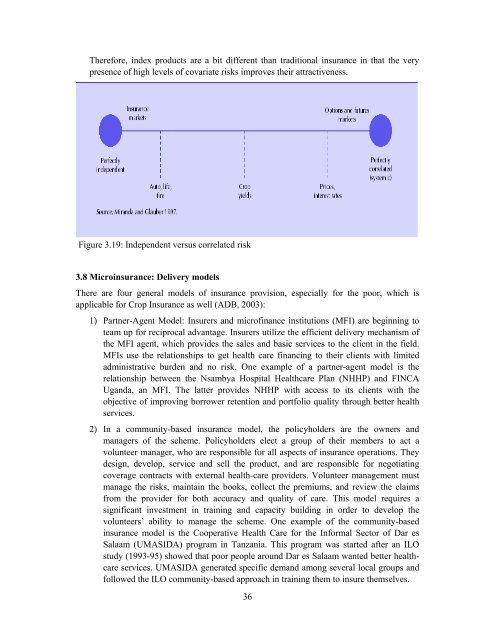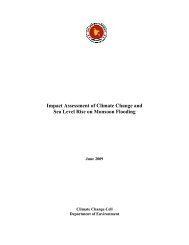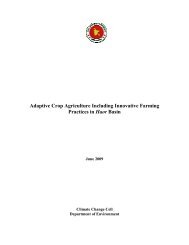Crop Insurance as a Risk Management Strategy in Bangladesh
Crop Insurance as a Risk Management Strategy in Bangladesh
Crop Insurance as a Risk Management Strategy in Bangladesh
Create successful ePaper yourself
Turn your PDF publications into a flip-book with our unique Google optimized e-Paper software.
Therefore, <strong>in</strong>dex products are a bit different than traditional <strong>in</strong>surance <strong>in</strong> that the very<br />
presence of high levels of covariate risks improves their attractiveness.<br />
Figure 3.19: Independent versus correlated risk<br />
3.8 Micro<strong>in</strong>surance: Delivery models<br />
There are four general models of <strong>in</strong>surance provision, especially for the poor, which is<br />
applicable for <strong>Crop</strong> <strong>Insurance</strong> <strong>as</strong> well (ADB, 2003):<br />
1) Partner-Agent Model: Insurers and microf<strong>in</strong>ance <strong>in</strong>stitutions (MFI) are beg<strong>in</strong>n<strong>in</strong>g to<br />
team up for reciprocal advantage. Insurers utilize the efficient delivery mechanism of<br />
the MFI agent, which provides the sales and b<strong>as</strong>ic services to the client <strong>in</strong> the field.<br />
MFIs use the relationships to get health care f<strong>in</strong>anc<strong>in</strong>g to their clients with limited<br />
adm<strong>in</strong>istrative burden and no risk. One example of a partner-agent model is the<br />
relationship between the Nsambya Hospital Healthcare Plan (NHHP) and FINCA<br />
Uganda, an MFI. The latter provides NHHP with access to its clients with the<br />
objective of improv<strong>in</strong>g borrower retention and portfolio quality through better health<br />
services.<br />
2) In a community-b<strong>as</strong>ed <strong>in</strong>surance model, the policyholders are the owners and<br />
managers of the scheme. Policyholders elect a group of their members to act a<br />
volunteer manager, who are responsible for all <strong>as</strong>pects of <strong>in</strong>surance operations. They<br />
design, develop, service and sell the product, and are responsible for negotiat<strong>in</strong>g<br />
coverage contracts with external health-care providers. Volunteer management must<br />
manage the risks, ma<strong>in</strong>ta<strong>in</strong> the books, collect the premiums, and review the claims<br />
from the provider for both accuracy and quality of care. This model requires a<br />
significant <strong>in</strong>vestment <strong>in</strong> tra<strong>in</strong><strong>in</strong>g and capacity build<strong>in</strong>g <strong>in</strong> order to develop the<br />
volunteers’ ability to manage the scheme. One example of the community-b<strong>as</strong>ed<br />
<strong>in</strong>surance model is the Cooperative Health Care for the Informal Sector of Dar es<br />
Salaam (UMASIDA) program <strong>in</strong> Tanzania. This program w<strong>as</strong> started after an ILO<br />
study (1993-95) showed that poor people around Dar es Salaam wanted better healthcare<br />
services. UMASIDA generated specific demand among several local groups and<br />
followed the ILO community-b<strong>as</strong>ed approach <strong>in</strong> tra<strong>in</strong><strong>in</strong>g them to <strong>in</strong>sure themselves.<br />
36





